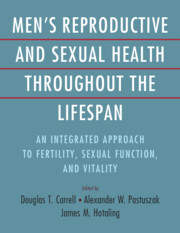 Men's Reproductive and Sexual Health Throughout the Lifespan
Men's Reproductive and Sexual Health Throughout the Lifespan Book contents
- Men’s Reproductive and Sexual Health throughout the Lifespan
- Men’s Reproductive and Sexual Health throughout the Lifespan
- Copyright page
- Contents
- Contributors
- Preface
- Section 1 An Introduction to Men’s Health Care
- Section 2 The Biology of Male Reproduction and Infertility
- Section 3 Clinical Evaluation and Treatment of Male Infertility
- Chapter 12 Office Evaluation of the Infertile Male
- Chapter 13 Medical Management of Male Infertility
- Chapter 14 Surgical Management of Male Infertility
- Chapter 15 Varicocele Repair in the Era of IVF/ICSI
- Chapter 16 Implementing Genetic Testing of Male Infertility in the Clinic
- Chapter 17 Andrological Care of the Patient with Spinal Cord Injury
- Chapter 18 Clinical Fertility Preservation Decision-Making for Prepubertal and Postpubertal Individuals with Male Gametes
- Chapter 19 Mental Health Considerations in the Infertile Male and Couple
- Section 4 Laboratory Evaluation and Treatment of Male Infertility
- Section 5 Medical and Surgical Management of Issues of Male Health
- Index
- References
Chapter 17 - Andrological Care of the Patient with Spinal Cord Injury
from Section 3 - Clinical Evaluation and Treatment of Male Infertility
Published online by Cambridge University Press: 06 December 2023
- Men’s Reproductive and Sexual Health throughout the Lifespan
- Men’s Reproductive and Sexual Health throughout the Lifespan
- Copyright page
- Contents
- Contributors
- Preface
- Section 1 An Introduction to Men’s Health Care
- Section 2 The Biology of Male Reproduction and Infertility
- Section 3 Clinical Evaluation and Treatment of Male Infertility
- Chapter 12 Office Evaluation of the Infertile Male
- Chapter 13 Medical Management of Male Infertility
- Chapter 14 Surgical Management of Male Infertility
- Chapter 15 Varicocele Repair in the Era of IVF/ICSI
- Chapter 16 Implementing Genetic Testing of Male Infertility in the Clinic
- Chapter 17 Andrological Care of the Patient with Spinal Cord Injury
- Chapter 18 Clinical Fertility Preservation Decision-Making for Prepubertal and Postpubertal Individuals with Male Gametes
- Chapter 19 Mental Health Considerations in the Infertile Male and Couple
- Section 4 Laboratory Evaluation and Treatment of Male Infertility
- Section 5 Medical and Surgical Management of Issues of Male Health
- Index
- References
Summary
Men with spinal cord injury often suffer from erectile dysfunction, ejaculatory dysfunction, infertility, and hypogonadism. Restoration of sexual and reproductive functions is a top priority and efficient treatment modalities exist. Erectile dysfunction can be treated with phosphodiesterase-5 inhibitors and if unsuccessful intracavernosal injections can be tried. When injections fail a penile implant can ultimately be an option. Anejaculation and the resulting infertility are treated in a stepwise approach with penile vibratory stimulation, electroejaculation and surgical sperm retrieval followed by assisted reproduction. Assisted ejaculation is an effective and safe procedure but carries a risk of autonomic dysreflexia, especially in men with injuries at the level of T6 or above. Autonomic dysreflexia is an unregulated and uncontrolled response of the sympathetic nervous system but it can be safely managed. Hypogonadism is more prevalent in men with spinal cord injury compared to the general population and testosterone replacement therapy can be beneficial for alleviating symptoms of low testosterone, but testosterone-related spermatogenic suppression needs to be considered in men who wish to initiate a pregnancy.
Keywords
- Type
- Chapter
- Information
- Men's Reproductive and Sexual Health Throughout the LifespanAn Integrated Approach to Fertility, Sexual Function, and Vitality, pp. 135 - 140Publisher: Cambridge University PressPrint publication year: 2023


